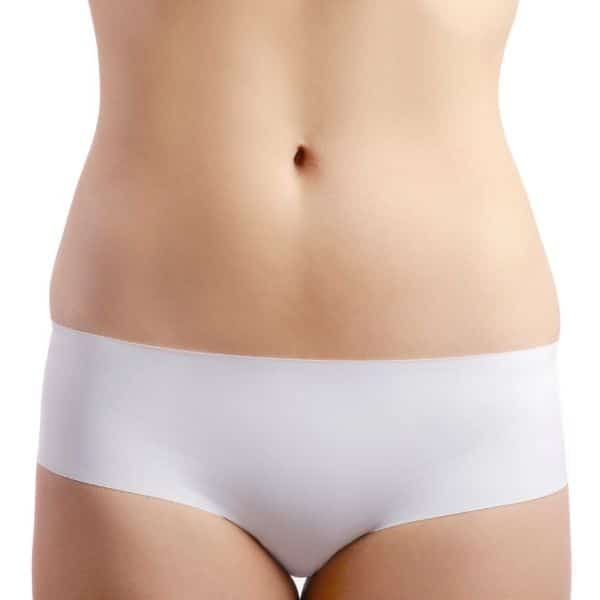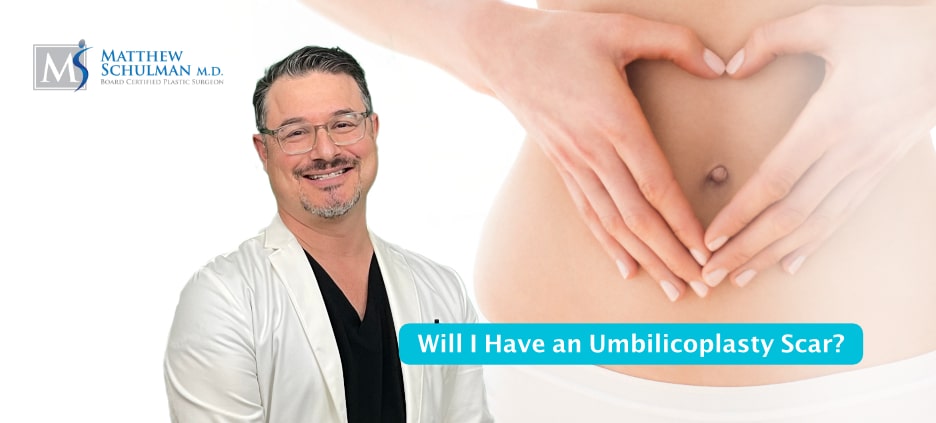Umbilicoplasty procedures may be performed for a number of reasons, making it difficult to predict what an umbilicoplasty scar may look like before actually meeting with the patient.
Some patients specifically choose umbilicoplasty to improve the overall appearance of a belly button scar. However, you can also undergo this procedure for other reasons.
Below, we’ll go over what patients with varying goals may expect in terms of scarring after umbilicoplasty, including an overview of why this surgery is performed and its potential benefits.
What Is Umbilicoplasty?
Umbilicoplasty is a plastic surgery procedure performed to reshape and improve the appearance of the belly button. There is also something called belly button scar removal surgery, which also falls under the umbrella of umbilicoplasty.
As the name implies, belly button scar removal specifically aims to fix a scar on or around the belly button — usually caused by a tummy tuck, liposuction, previous hernia repair, previous umbilicoplasty, or another medical procedure.
Will I Have a Belly Button Surgery Scar After Umbilicoplasty?

If a scar on the outside of the abdomen is inevitable, topical treatments can sometimes be used to improve scar appearance (silicone works well). It’s also important to follow your aftercare instructions, avoid intense exercise, avoid weight gain, and not strain the treatment area (try to avoid even natural stretching of the abdomen for a while).
Patients should also keep the treatment area out of sun after having an umbilicoplasty performed.
Who Should Undergo Belly Button Surgery?
Patients undergoing belly button surgery should be in good health and at a healthy weight. Patients should be non-smokers and have realistic expectations. Ideal patients are self conscious or uncomfortable with the appearance of their navel.
There are many reasons why a patient may seek belly button surgery:
Umbilicoplasty to Change an “Outie” to an “Innie”
It’s difficult to predict whether a baby will have an outie belly button or an innie belly button.
The belly button (navel) is, of course, the entry point for the umbilical cord while a baby is in their mother’s womb. Once a baby is born, the umbilical cord is cut and clamped. This wound eventually heals, and the result is the belly button.
Some think the appearance of the belly button is determined by how the umbilical cord is cut and clamped. At the same time, some individuals seem predisposed to have an outie or an innie. Furthermore, later in life, the amount of fat and muscle around the belly button also determines what the navel looks like.
Regardless of these factors, many adult patients don’t like their outie belly buttons. So, umbilicoplasty is a cosmetic surgery that can be performed to change an outie to an innie.
Umbilicoplasty for Loose Skin
Some patients have excess skin around their belly buttons. This could be due to significant weight loss, previous pregnancies, genetics, or aging. Umbilicoplasty for loose skin is a cosmetic procedure that can remove the unwanted skin and improve the appearance of the belly overall.
Umbilicoplasty with Tummy Tuck or Liposuction
Patients who desire a tummy tuck or liposuction on their abdomens often select umbilicoplasty as an add-on procedure. This is common with mommy makeover surgery or for patients who simply want to reduce excess skin or fat from their midsection.
Any such combination procedure allows a patient who may be unhappy with the appearance of their belly button to improve many aspects of their abdominal area.
Excess skin surrounding the belly button and entire abdominal area can be reduced while unwanted fat is suctioned out, and the underlying muscles are tightened (with abdominoplasty).
Umbilicoplasty Due to Hernia
An umbilical hernia creates swelling around the belly button. The condition is actually caused by a small piece of intestine being caught in the belly button opening. It occurs most commonly in infants, and infants and small children can undergo a common surgery to repair the issue.
Of course, adults can have umbilical hernias as well. In fact, many adults with this condition have no idea they have it. They may find out when they come into our office curious about surgery for removing excess navel skin and making their belly button more attractive.
We often repair umbilical hernias with umbilicoplasty. The hernia is repaired, and Dr. Schulman aims to create a belly button that the patient will be happy with, reducing scar tissue as much as possible. Often, patients desire an innie belly button with a vertical shape.
As a side note, some patients who come to us for an umbilicoplasty procedure have already had surgery to correct an umbilical hernia. This surgery can cause a belly button hernia surgery scar, which Dr. Schulman can then correct with a surgical revision — usually only a small incision and a special surgical technique to improve the appearance of the entire area.
Umbilicoplasty Due to Piercing Scar
When looking into plastic surgery belly button piercing scar issues are another common reason for umbilicoplasty. Patients may have had a belly button piercing in the past and are either unhappy with the resulting scar or want to get rid of any trace of the piercing altogether.
There are actually several cosmetic procedures that aim to get rid of old piercing scars. These types of plastic surgery procedures can be performed on the ears (often after having gauges), on the eyebrows, nose, and elsewhere. The belly button is a common area.
FAQ: Umbilicoplasty
What will I feel like after umbilicoplasty?
Most patients feel fairly good during the majority of their umbilicoplasty recovery. Usually, patients only require an initial recovery time of one to two days unless they had other procedures performed as well.
How much is umbilicoplasty?
Your final umbilicoplasty cost will depend on several factors.
These include who your surgeon is, the type of anesthesia used (local anesthesia or general anesthesia), the length of your surgery (most umbilicoplasty procedures usually take about an hour), where you undergo surgery (geographic location), the techniques used, and other factors.
Request Your Consultation Appointment

Whether you want to change your “outie” to an “innie”, require an umbilical hernia, need to undergo a scar revision procedure after a piercing or prior surgery, or have another reason for umbilicoplasty, Dr. Schulman can help. Please call our NYC office today to book your initial consultation.




